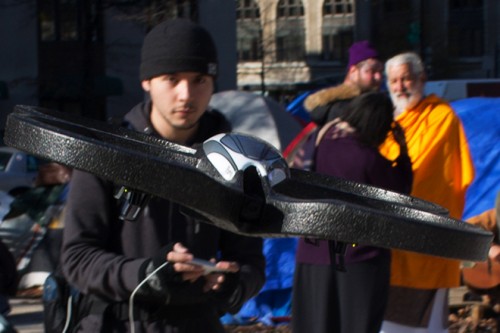
The death machines made new death and she drove the aliens from the desert, reclaiming the craters and jagged rocks and dry brush as hers and hers alone, for her heart is the heart of the death machines and no longer has room for any other.
– “A Shadow on the Sky” (unpublished)
Last weekend – as anyone will know if they’ve been paying even marginal attention to this blog – the fourth annual iteration of Theorizing the Web took place, featuring panels and plenaries on selfies, the attention economy, activism, memes, sex work, race and social media, big data, and more other amazing stuff than I could reasonably list here (look, just go look at the program).
Among the rest of that awesomeness, we also hosted a symposium on drones, which featured James Bridle, Olivia Rosane, Adam Rothstein, and Eleanor Saitta, and which I had the great privilege of moderating (here’s a link to a link to a place where it can be viewed).
This particular conversation about drones is a couple of years old now, and it’s been fascinating to watch it evolve as periodically I get to pop in and contribute to it in various odd ways. The discussion in this particular setting covered a lot of different patches of ground, but one particular question stood out to me: To what degree can those without much political power reclaim/make use of a category of technology that was created to be both agent and enforcer of coercive state power?
Because technology, as all the panelists noted and as many others have done, isn’t neutral. Design isn’t separable from the designer’s intent and political context. Some drones are made to surveil, and many are made to kill, and just because they also have a variety of “non-violent” civilian uses doesn’t necessarily mean that the violence inherent in the code – so to speak – is erased.
Does it? I mean, I don’t know. The general conclusion of the panel seemed to be “hell no, it’s still there”, and I find that a compelling position, but I’m still troubled by the very question, and in part that’s because I’m very attracted, on a gut level, by the idea of using the master’s tools to tear down the master’s house, as intensely problematic as that idea is. It appeals to my sense of ironic justice. But I’m also enough of a realist to know how unlikely that is.
So we see Occupy using a quadcopter as a potential way to watch the watching police. We see Russian citizen journalists using similar tech to capture amazing aerial photos of election protests. We see the potential of this technology for empowerment, resistance, the ability to look back. But is that good enough?
Another major observation to come out of this entire conversation is how complex and ambivalent is our relationship with drones. Hobbyists love their quadcopters and insist that they have nothing to do with Reapers and Predators and Global Hawks. Environmental groups insist that they can help with conservation efforts. But we construct a hopelessly complex network of fearful cultural connotations around them, and they’re sites for the revelation of existing systems of social power – a more positive relationship with this technology is a function of privilege, of having no obvious reason to fear that a drone will watch or kill you. When Olivia, Adam, and I sat on a panel at the Drones & Aerial Robotics Conference this past fall – James Bridle was also there, on a separate panel – I couldn’t help noticing that it was awfully white (and so was the symposium at Theorizing the Web, incidentally).
But the title of the symposium was “Drones, for Better or Worse”. We exist with these machines. There’s almost certainly no going back. The open question – and I do think it’s still open – is whether we can live with them or against them. Or which position we should adopt, or attempt to adopt.
Adam (I think it was him, someone please correct me if I’m wrong) said during the discussion that in order to beat a sword into a ploughshare, one has to literally remake it. It’s not a simple process of alteration but of melting down and reforming. That suggests a certain kind of relationship between a human and a machine, to the extent that we can still differentiate the two. It both suggests possibilities and forecloses on them, and it implies certain obligations, depending on what kind of society you want to live in.
So I’m still not sure what to make of this. Let’s keep talking.
Sarah mrrmmmmmmmmms on Twitter – @dynamicsymmetry

Comments 2
ArtSmart Consult — May 1, 2014
If we broaden the scope of what we categorize as technology, we see that technology is less owned than we think it is, and every technology can be turned. Absolutely one can use the master’s tools to tear down the master’s house, because the master has yet to master the master's tools.
I prefer to use the term autonomous rather than drone. Autonomous is not the same as remotely controlled or programed. If it's truly autonomous, it's less predictable and yet more persuadable.
atomic geography — May 4, 2014
Sara, wish I could've been there
Heidegger's critique of technology relies on describing the technological understanding of being. Drones as a particularly vivid example of space transducer (combatants are 18" away, no a couple of hundred feet, no thousands of miles apart) instantiate this understanding. I think this is how the violence is encoded, not in the 0's and 1's, but in our understanding of how these things and ourselves exist in the world.
Can then a Harawayian understanding of cyborg being overcome this? I don't know. How does such a cyborg wage war and not (seemingly off topic, but I think it gets there)name the enemy